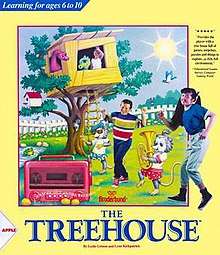The Treehouse (video game)
The Treehouse is an educational point-and-click personal computer game developed for MS-DOS and then ported to Macintosh and the FM Towns, with Windows versions arriving later. Following the success of The Playroom, Broderbund created The Treehouse, which provides more content and furthers the user's ability to explore.[3] First released in 1991, most copies were sold in educational supply stores rather than mainstream stores that sold computer software; it included a sing-along cassette tape.[4] It was re-released in 1996 for Windows 3.1 and Windows 95. Although the Windows version has the same general activities, the characters, interface, and locations are different.
| The Treehouse | |
|---|---|
 Apple II cover art | |
| Developer(s) | Brøderbund |
| Publisher(s) | Brøderbund |
| Producer(s) | Janese Swanson |
| Designer(s) | Leslie Grimm[1] Lynn Kirkpatrick |
| Artist(s) | Fred Dianda |
| Composer(s) | Tom Rettig |
| Series | Early Learning Family Series |
| Engine | Mohawk |
| Platform(s) | MS-DOS, Apple II, Macintosh, FM Towns, Windows |
| Release |
|
| Genre(s) | Educational |
| Mode(s) | Single-player Two-player (in certain games) |
Art and animation
Artist Fred Dianda did the artwork and sprites for the 1991 version; he stated that he "enjoyed the research of musical instruments" for The Treehouse. The backgrounds were done with a minimal palette of 8 colors with 44 different shades and various dithering effects implemented to create the illusion of even more colors.[5]
Gameplay
The game's main characters are two opossums who at various times either want to play or take a nap. The activities within the game include music composition and learning, a music maze, a picture scene with interactive objects, a puppet show and a Monopoly-style game that teaches counting and currency concepts.[6]
Educational goals
The game is designed for older learners than The Playroom.[7] The subjects in the game include math, language, music, creative art and science.[8] Children are encouraged to explore new places, learn new facts and put their creative skills to use.[9]
Reception
| Reception | ||||||||||
|---|---|---|---|---|---|---|---|---|---|---|
| ||||||||||
Computer Gaming World gave The Treehouse five out of five stars, stating that it had a "rich, full environment" with "excellent sound effects"[10] and placed it as one the SPA Top Hits for Home Education.[12]
References
- "Leslie Grimm Ph.D." (PDF). Talking Fingers Inc.: 1. Retrieved 3 June 2016. Cite journal requires
|journal=(help) - "Computer Gaming World Issue 83" (PDF) (83). Computer Gaming World. June 1991: 85. Retrieved 8 June 2016. Cite journal requires
|journal=(help) - Buckleitner, Warren (December 1991). "25 top children's programs". Compute! (Issue 136): Page S10 – via atarimagazines.com.
- Lewis, Peter H. (November 3, 1991). "Software; Shopping At Home". New York Times. Retrieved September 21, 2018.
- Fred Dianda. "Fred's Artwork". Retrieved June 2, 2017.
- Beth Ann Murray (September 1991). "Compute! Issue 133". Compute!. No. 133. p. 113. Retrieved June 6, 2016.
- Eiser, Leslie (February 1992). "The Treehouse - After Hours". Technology & Learning. Vol. 12 no. 5.
- "Brain Gain - Compute!". Compute!. No. 136. December 1991. p. 139.
- "The Treehouse - After Hours". PC Magazine. Vol. 11 no. 6. Ziff Davis. March 31, 1992. p. 451.
- Ackelson, Caitlin (February 1992). "Computer Gaming World Issue 91" (PDF). Computer Gaming World. No. 91. p. 44. Retrieved 8 June 2016.
Provides the player with a treehouse full of games, surprises, puzzles and things to explore...a rich, full environment.
- "The Treehouse - GameSpot". GameSpot. Retrieved June 6, 2016.
- "PC Research/SPA Top Hits". Computer Gaming World. No. 97. August 1992. p. 70.